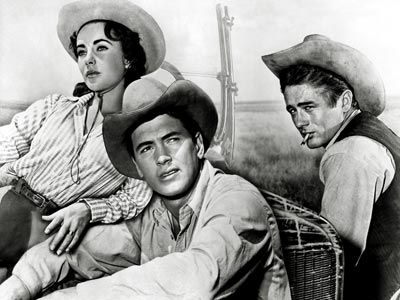Like any legendary beauty nearing the half-century mark, the sweeping movie that put Marfa on the map and theTexas way of life on celluloid has aged superbly – Giant at well past 50 now.
Big? Yep. Grand? You bet. Giant? Definitely. The epic movie about Reata, a fabled 595,000-acre West Texas ranch and its inhabitants, changed the way the world viewed Texas. There’s no denying the vast impact of the myth, the film and the West Texas area where it was shot in the summer and early fall of 1955.
Inspired by real-life Texas oilman Glenn McCarthy, Edna Ferber’s 1952 best-selling book, on which the movie is based, captured all that was right and wrong with Texas, and the country, at the time. According to Hollywoodscreenwriter Ivan Moffat, who adapted the screenplay, “The novel wasn't very popular among Texans to begin with. One Dallas paper claimed that if the film was shown in Texas, the screen might be shot full of holes.” Yet the pioneer spirit glorified in the film is alive and well in the region today, with some of its inhabitants betting on Marfa and its surroundings as an international art world player– even when your average Texan may not have made the pilgrimage west. The film, like its home turf, is continually being rediscovered and discovered for the first time as a classic.
Giant is a story that reflects four generations of Texans as tightly wound as a new lasso. But the movie almost didn’t unravel the way we now know it. Grace Kelly vied for the role of Leslie Benedict until Elizabeth Taylor was awarded it, while James Dean almost lost the part of Jett Rink to decades-older film veteran Alan Ladd. Both Taylor and Dean sizzle onscreen. Director George Stevens knew his story - and how to tell it with the right talent. In fact, he won an Oscar for it; Giant was nominated for 11.
Taylor once said that Dean “had not only the training of method acting, but I think he was also instinctive.” Rock Hudson as the cocky, young ranch baron Bick Benedict personified the evolution of the old way of life into new, while Mercedes Cambridge as the independent sister created a vision of Texan women archetypical today. Dennis Hopper, a teenager at the time, played the son who shirks his ranch roots to become a doctor. On the set Hopper became fast friends with James Dean and was mesmerized by his talents during the filming. He referred to his experience with Dean recently in a television interview, “I was just astonished by him. I asked him, ‘I gotta know what you’re doing as an actor. I don’t understand it.’ And he said, ‘Well, if you’re smoking a cigarette, just smoke the cigarette, don’t act smoking the cigarette…and you just go to a moment-to-moment reality.”



